The 2nd Magical Key To The Spine Engine
LUMBAR LORDOSIS
LUMBAR LORDOSIS
by Kelvin Miyahira
Last month I covered the first of two of the important moves in engaging the spine engine, the lateral bend. This month I’ll detail the second magical key that opens the gates to a truly athletic golf swing, lumbar lordosis. Lumbar lordosis is extremely important for two reasons; one is because it allows the spine gears to remain connected and two, you can get added power from a source you probably never heard of, but use in everyday life.
For demonstration of how the spine is designed to work, see the YouTube video link below. While we believe that the spine facets are integral in enabling the body to perform amazing movements optimally, some people see these spine facets as hindrances to rotation. See LINK DOWN!
Then take a look at a video of the fundamental properties of a rod and why Dr. Gracovetsky and other spine researchers believe the spine behaves similarly. http://www.youtube.com/watch?v=aNvi1kdo4Wg
For demonstration of how the spine is designed to work, see the YouTube video link below. While we believe that the spine facets are integral in enabling the body to perform amazing movements optimally, some people see these spine facets as hindrances to rotation. See LINK DOWN!
Then take a look at a video of the fundamental properties of a rod and why Dr. Gracovetsky and other spine researchers believe the spine behaves similarly. http://www.youtube.com/watch?v=aNvi1kdo4Wg
Before I get to the lumbar lordosis, let it be said that many golfers do not even try to get these moves done, nor are they taught this and must perform the swing with muscular power, pretty positions, and perfect planes. Virtually, all golf methodologies (except for Butch Harmon and a few others) have not understood how the human body works optimally.
Ironically, most all of the “PGA stars” that headline these teaching systems already possess these spine engine moves via natural, inborn athleticism vs. being taught these moves. Therefore, they are only taught the superficial, cosmetic moves and off to the races they go. It’s like they’ve already got the Ferrari engine and all they need is some new tires and a paint job.
However, unbeknownst to the legions of followers to these systems, they are not taught the athleticism part, only the cosmetic positions and motions. And if not careful, sometimes even these PGA players can get caught up in the superficial and lose the natural athletic spine engine moves that made them great.
The good news is that the spine engine movements are deeply instinctual. Thus, these moves can be recovered easily with proper instruction as we are seeing that Phil Mickelson has fully recovered from being “RickSmith’ed.” So regaining the use of these motions is possible with anyone, however it may take some work on your body.
First, what is lumbar lordosis?
Lumbar lordosis is the natural curve of a normal person’s posture. Typically, a lumbar (lower spine region) is curved concavely when viewed from the side. It is easy to see in the address position from the target line view.
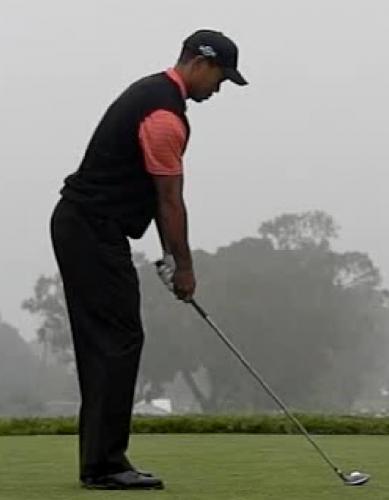
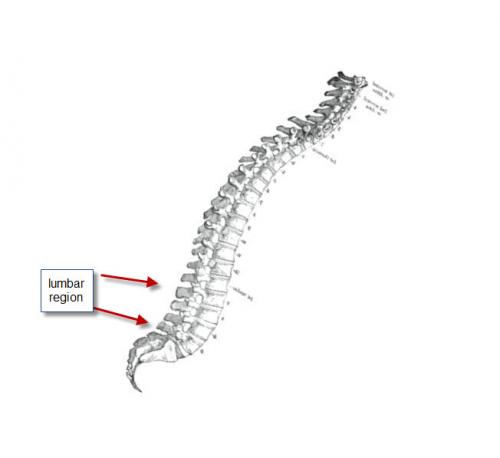
This is pretty simple when we are looking at posture.
This has been said many times in many different ways. Some people call this a spine angle or retention of one’s spine angle. But I think this is awfully simplistic since the spine is curved three dimensionally and at different points of the swing, contorted in the X, Y and Z planes of motion unless you’re frozen like a block of ice and just turning. Thus, the movements are rather complex.
So let me give you my take on the spine “angle” and how it is ever changing throughout the swing.
Address position
See picture above for Tiger’s 2008 posture. His lower spine shows a slight arch or lordosis. On the right is a normal spine tilted to simulate a golf posture.
This is simple enough to understand, right? However, setting the lumbar lordosis at address, then turning on the backswing and turning on the downswing isn’t all there is to it.
The key is in varying the amount of lumbar lordosis during the swing. Also we are combining the lateral bend with the lumbar lordosis to set the spine gears in place. Any disconnecting of the gears at any point prior to contact will produce an adverse swing reaction (most likely, a hip or shoulder stall) that will cause other problems to occur such as casting, flipping, lunging, jumping, etc.
So let’s take a look at lordosis and see how it transforms itself during different phases of the swing.
Top of the backswing and transition
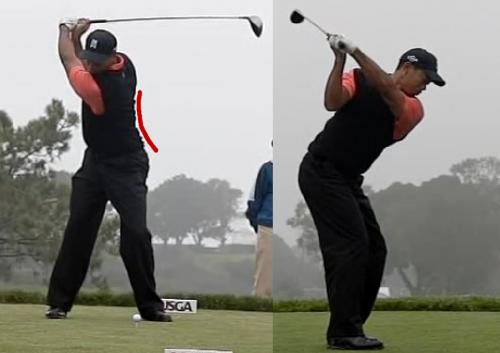
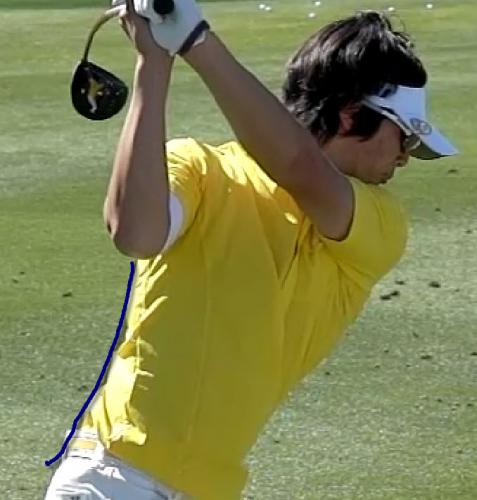
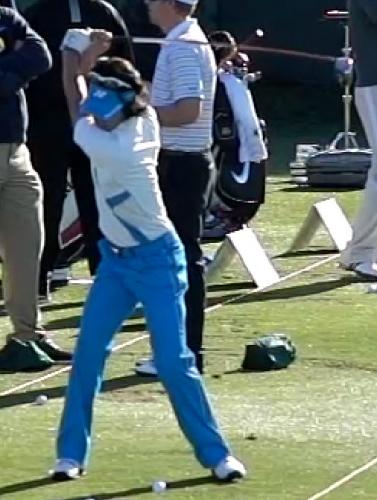
Mr. 58, Ryo Ishikawa shows his lumbar lordosis and lateral bend.
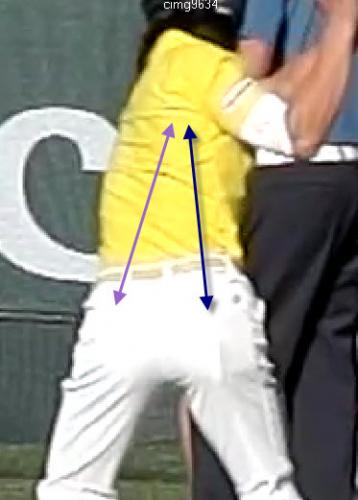
Notice the arrows showing how the contractions of his muscles are pulling his right shoulder in two ways. It is pulling toward both of his glutes for lordosis and toward his right glute especially for lateral bend. Another key point is that his rectus abdominis is stretching here.
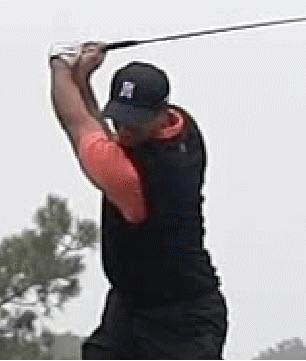
From the front view, you can see that Tiger’s lumbar lordosis or arching increases as he finishes the backswing. See the curve in his spine? In an earlier article we called this anterior pelvic tilt, which is occurring as well, but henceforth, we shall use Dr. Gracovetsky’s term of “lumbar lordosis.”
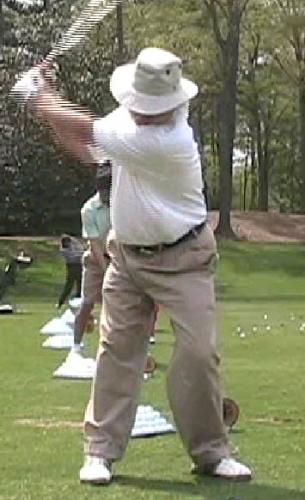
Remember the left side of Tom Agricola’s backswing looked like a straight line? This is due to the lack of lumbar lordosis. Soon after takeaway, he relaxed his lower spine muscles and shifted his hips to the left too early. In doing so, he lost his lordosis and spinal loading.
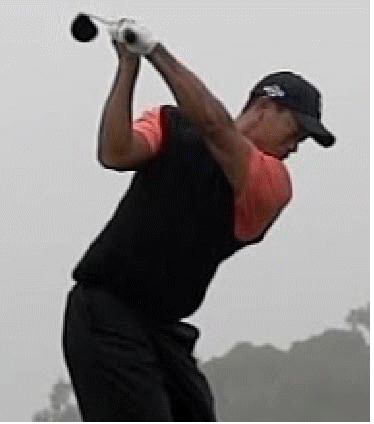
From target view, you can see the lordosis and lateral bend increase as the drop occurs in his right side as well.
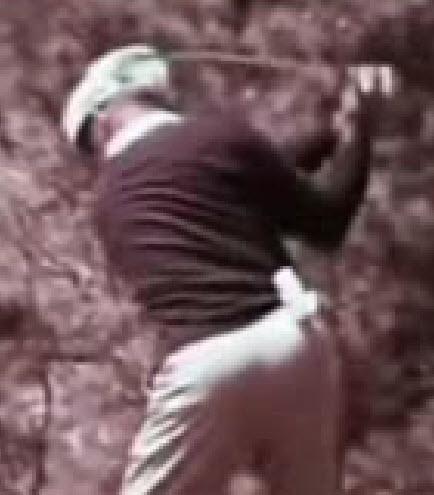
Here’s Ben Hogan with a very good lateral bend and lordosis. Notice that it creates a concave appearance in his back. The concave appearance, or what we called the “anaconda position,” shows that lateral bend and lordosis is present.
Besides the locking of the spine facets together, a very powerful mechanism is brought into play by these two coupled motions.
Posterior Ligamentous System
What’s also happening in the great golf swings is the optimal use of the Posterior Ligamentous System (PLS). The PLS is made up of the thoracolumbar fascia (white stuff pictured below where the “X” is) and two ligaments directly on the spine; supraspinous and interspinous ligaments. This is hugely important for the power development in the spine engine. Lateral bend and lordosis during the transition and early downswing are stretching the PLS to create the axial rotation just as in the ruler demonstration.
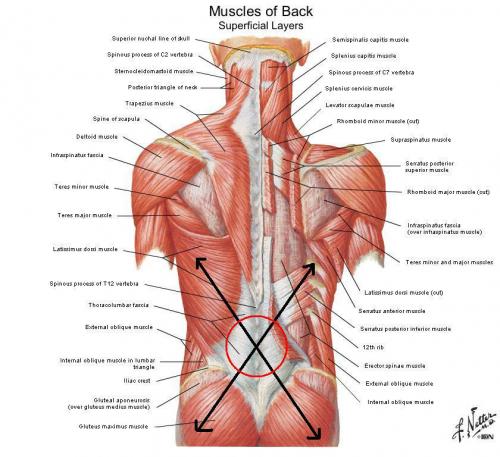
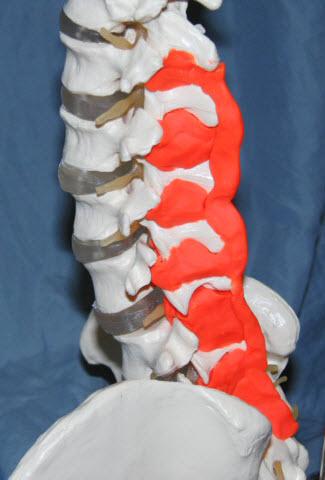
See all the white stuff? That’s where all that stretchable, elastic ligaments, tendons, and fascia are. Picture on the right (in orange so it can stand out) shows where the supraspinous and interspinous ligaments are.
Many people view body movement directly related to muscle movement in a very simplistic sense. They see it as a muscle that contracts, then body parts move. Well, it’s a bit more complicated than that especially when thinking of a complex movement.
For example, if you’re going to throw a ball, you wind up the muscles, stretch then throw. But if you look a little closer into it, the muscles are attached to tendons and tendons to bones. Then bones are attached via ligaments to other bones, and so on. At every junction, there is this connective tissue that is elastic, stretchable and capable of multiplying muscle force.
Now your body is made up of many bones (each disc), ribs, hip, legs, etc. There is a huge amount of this connective tissue that can make your golf swing more powerful, if you choose to use it (locking your spine in a stiff, straight line is a way of not using it). Recent studies have found that the connective tissue even possesses actin, an important cog in the muscle contraction process.
Feel Drill for Early Downswing
So try this while you’re sitting at your computer. Turn your shoulders about 45 degrees (X-factor of 45 since your hips aren’t turning) and do the lateral bend and then add in lordosis. If you’re doing this right, you should feel a stretch in the left side of your torso. You should feel it in your left rib cage area, abs and diaphragm. What’s also stretching at that point is the white stuff in your spine engine and you should feel ready to spring into action.
Lordosis in Early Downswing
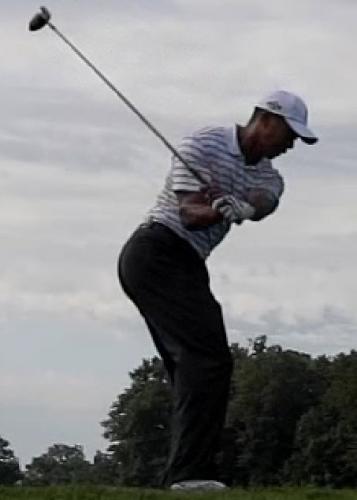
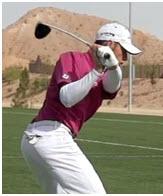
This stage of the downswing still shows the lordosis and lateral bend.
Lumbar Lordosis near Impact and the Posterior Ligamentous System
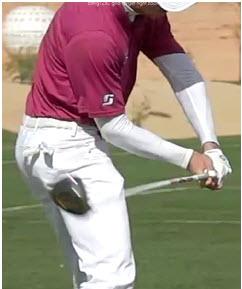
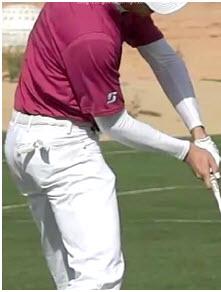
Just before impact, a transformation begins to occur. The right side retains lordosis while the left side of the body begins to lose lordosis. This is absolutely critical!
The right side must retain the lordosis so that the gears remain connected and rotation can continue through the impact zone. But what is really interesting is what’s happening to the left side of the body.
In the impact zone, when the powerful leg and hip extensors are firing, the PLS is the “primary force transmission mechanism” according to Gracovetsky. The PLS connection from the hip bone to the spinous processes (facets) allow the direct flow of force to pulse the spine engine to rotate faster via an elastic recoil that is more powerful than just muscular force. HOWEVER, the hips must be in the proper place in order for this to work. Being too far past the chi line is not going to produce the desired result of faster spine engine rotation when the leg fires. It will produce a jump/stall. More on this later.
Also, the PLS must be in a stretched position to allow the transfer of force. The way to do this is by reducing the amount of lordosis on the left side of the body while still connecting the facets with lordosis/lateral bend on the right side.
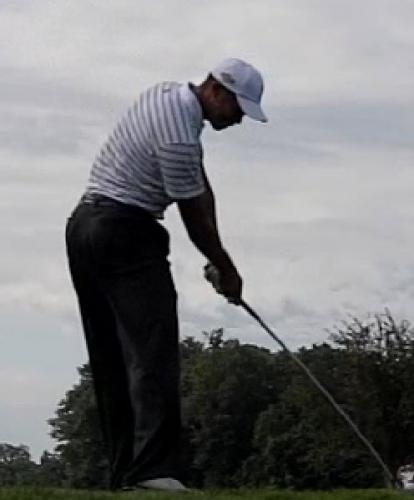
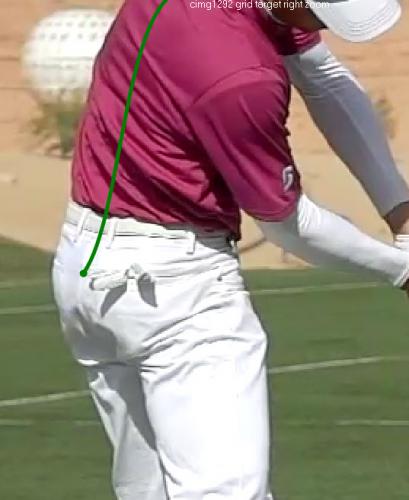
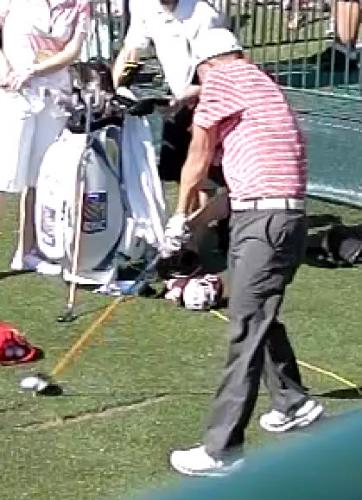
When you see a rounded “C” shaped impact position of the left side like AK has, he is definitely using the PLS and using it to perform its function optimally.
Feel Drill for Impact
In order to learn this impact position, try an isometric exercise using a door knob. Grab the knob and try to pull using your back muscles only. Note how much force you can apply.
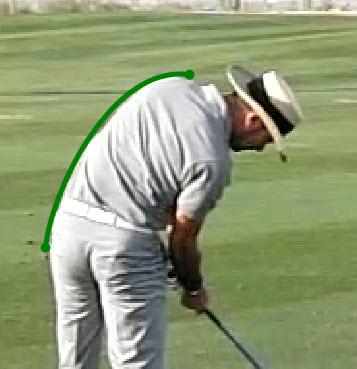
Next, try to get the “C” position by rotating and stretching your left side as far as it will go while holding the doorknob. Alvaro Quiros shows his whole left side stretched in the “C” position. Notice how much more powerful you are when accessing your PLS.
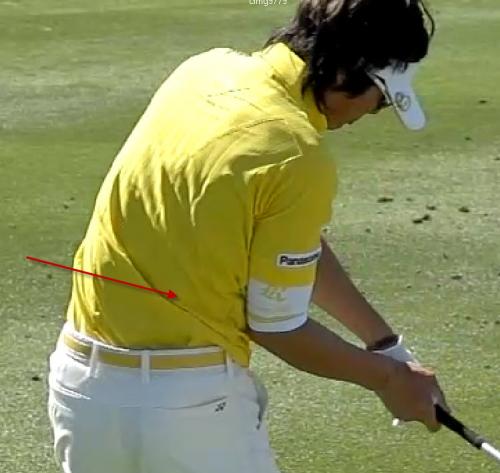
Last, add in the hip rotation and you should feel a contraction focal point in the backside of your obliques on the right side (red arrow). If you can imagine this point to be where my right thumb was on the ruler in ruler demonstration. While the left side of the body is pulling around in the “C” shape, the right side is pushing forward here.
Contrastingly, traditional instruction has focused on the shoulder, hip or legs driving the swing and perhaps this is why we see so many disconnected swings. Some athletes can do tremendous things without instruction. But the majority of us need exacting instruction in order to get it right. This is one huge part of getting it right.
Lordosis Post Impact
An important safety measure occurs after impact. Rick calls it “thoracic spine release.” What he means is that the entire spine cannot rotate forever and the lower body will reach the end of its rotation soon after impact. Thus, the lordosis can be released, spine engine can be disengaged and the thoracic (middle back) spine is freed to allow the upper torso to rotate till the end of the swing.
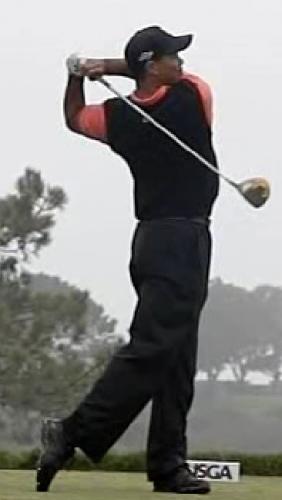
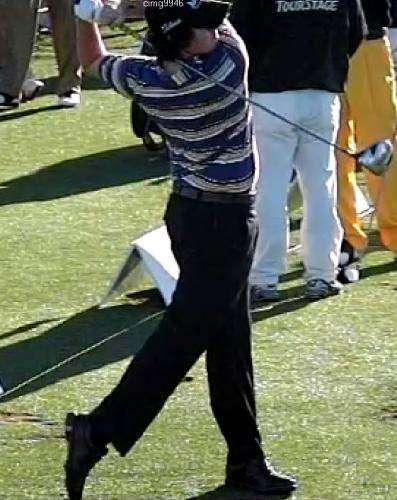
If the thoracic release occurs, it will allow the shoulders to rotate through easily.
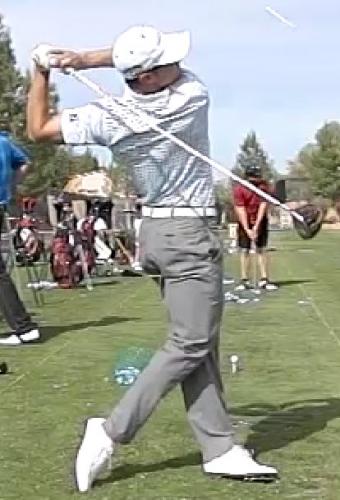
Way to Retain Lordosis: Sacrum Movement Pattern
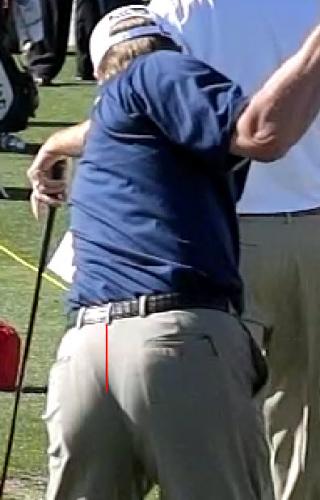
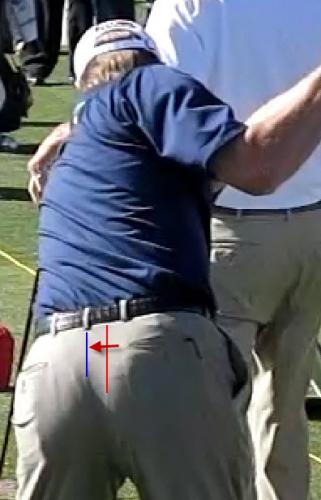
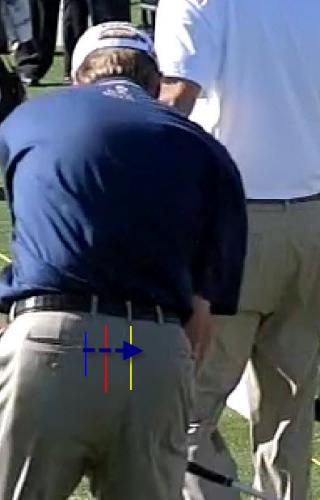
One of the keys to retaining the right amount of lordosis throughout the swing is having the correct sacrum or tailbone movement. Let’s take a look at the great, simple swing of Steve Stricker. The red line represents the position of the tailbone just before transition starts in the first picture.
Then, the sacrum or tailbone moves about an inch toward the target during transition (blue line). This is the sign of a spine driven swing. Then it rotates and begins to move away from the target during the downswing (yellow line).
This is the same movement pattern as a great baseball hitter uses. The baseball hitter typically strides, then rotates. So it makes logical sense that golfers could use the same moves.
Yet, most golfers keep shifting their tailbone forward toward the target even after they’ve shifted left and this causes hip stalls.
Common Errors
Reverse Sacrum Movement
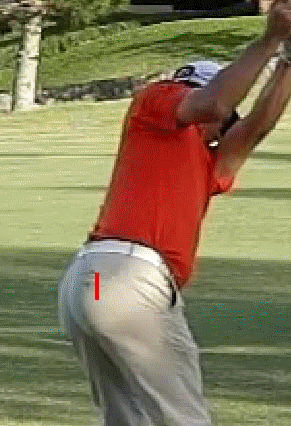
Here’s another PGA tour player (might be Nicholas Thompson) using the reverse order of the sacrum move. Notice the sacrum moves away from the target in the early downswing followed by a thrust forward toward the target in the last few frames before impact. As he thrusts forward, he loses lordosis, unlocks the gears and therefore loses the ability to rotate.
Hip Thrust
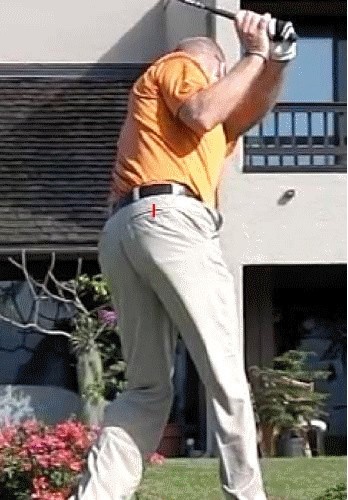
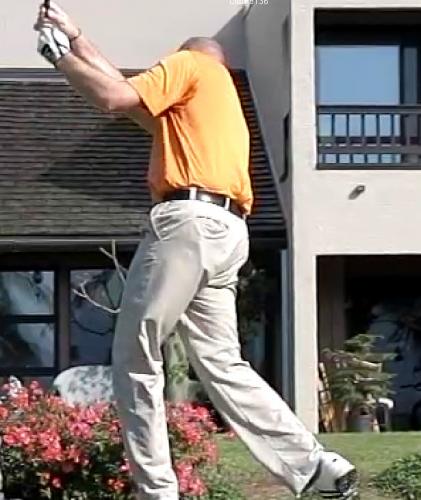
Here’s another unnamed PGA tour pro that was playing at the satellite pro am with an odd looking follow through. Despite having a good transition and first part of the downswing, he loses his lordisis by driving his legs towards the target through impact. Also, as he thrusts his hips forward and toward the ball, he loses his lateral bend. This completely disengages the gears and we see a hip stall, then upper body lunge.
The Jump/Stall
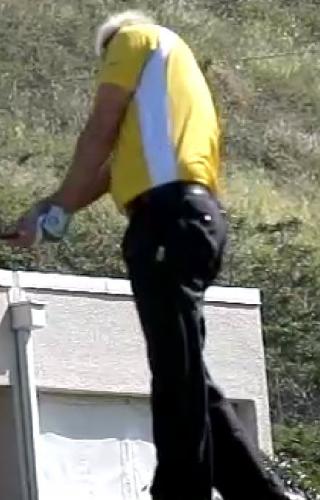
Here’s Daniel Chopra with a common swing error shared by many amateurs. He slides too far left and by the time his legs fire, they can only generate a vertical jump vs. a jump and rotation. His upper body and legs look like they form a straight line. Once again, here is a case of an extremely good athlete that can get away with lesser mechanics.
So as you can see, the movements involved in the spine engine swing are pretty simple in that there are two huge moves and many micro moves associated with them. This gives us a foundation upon which we can build a golf swing and also diagnose true root causes to dysfunctions. One caveat though, your spine must be in good health in order to perform these moves optimally and easily. If your spine is not, read more below.
Exercising and training one’s Lumbar Lordosis


I know the older crowd is already saying, “I can’t swing like those young guys.” Well, that’s probably true but there’s a reason and it’s not terminal. If you’re over 40 years old, chances are you’re suffering from some spine compression that causes pain or stiffness in the lumbar area. Long distance running, use of treadmills or playing tennis on hardcourts, create a constant pounding on the spine that causes compression and eventually an abnormal spine curve as shown in the pictures above. Even the constant force of gravity is at work slowly compressing your spine till it is no longer capable of the movement required for a great golf swing.
And if you have one of these flattened spinal curves, you will face difficulties in performing the golf swing correctly since there is no way to compensate for this loss of lordosis and lateral bend that’s missing. Thus, no matter how hard you try to fix your “golf swing,” the problem may lie deeper in the spine’s inability to move.
Good news! I found a great product called the “Posture Pump” that allows me to rehydrate my spine on a daily basis. At the same time, it is reshaping my lumbar curve that was totally gone. Even better, it is returning flexibility to my lumbar area I thought was lost forever. I went from a foot from touching my toes to about one inch from touching my toes in just a few weeks and my lower spine moves much better. Since this product is a little pricey, you can also do these exercises with a foam half roller though it isn’t anywhere near as comfortable.
See a remarkable transformation of a 50 year old’s golf swing on youtube http://www.youtube.com/watch?v=4XFPfUetf_s
Another contributor to spine compression and stiffness can occur from dehydration. Yes, that’s right. Dehydration from lack of drinking water (no, soda, coffee, tea or adult beverages don’t count as water) can also contribute to lack of spinal mobility as well as non-optimal health. People might want to read the work of Dr. Fereydoon Batmanghelidj, especially his book, “Your Body’s Many Cries for Water.”
Side notes: Michael Breed wants everyone to have quiet feet. Should you follow? See great swing of Tim Clark.
Ironically, most all of the “PGA stars” that headline these teaching systems already possess these spine engine moves via natural, inborn athleticism vs. being taught these moves. Therefore, they are only taught the superficial, cosmetic moves and off to the races they go. It’s like they’ve already got the Ferrari engine and all they need is some new tires and a paint job.
However, unbeknownst to the legions of followers to these systems, they are not taught the athleticism part, only the cosmetic positions and motions. And if not careful, sometimes even these PGA players can get caught up in the superficial and lose the natural athletic spine engine moves that made them great.
The good news is that the spine engine movements are deeply instinctual. Thus, these moves can be recovered easily with proper instruction as we are seeing that Phil Mickelson has fully recovered from being “RickSmith’ed.” So regaining the use of these motions is possible with anyone, however it may take some work on your body.
First, what is lumbar lordosis?
Lumbar lordosis is the natural curve of a normal person’s posture. Typically, a lumbar (lower spine region) is curved concavely when viewed from the side. It is easy to see in the address position from the target line view.


This is pretty simple when we are looking at posture.
This has been said many times in many different ways. Some people call this a spine angle or retention of one’s spine angle. But I think this is awfully simplistic since the spine is curved three dimensionally and at different points of the swing, contorted in the X, Y and Z planes of motion unless you’re frozen like a block of ice and just turning. Thus, the movements are rather complex.
So let me give you my take on the spine “angle” and how it is ever changing throughout the swing.
Address position
See picture above for Tiger’s 2008 posture. His lower spine shows a slight arch or lordosis. On the right is a normal spine tilted to simulate a golf posture.
This is simple enough to understand, right? However, setting the lumbar lordosis at address, then turning on the backswing and turning on the downswing isn’t all there is to it.
The key is in varying the amount of lumbar lordosis during the swing. Also we are combining the lateral bend with the lumbar lordosis to set the spine gears in place. Any disconnecting of the gears at any point prior to contact will produce an adverse swing reaction (most likely, a hip or shoulder stall) that will cause other problems to occur such as casting, flipping, lunging, jumping, etc.
So let’s take a look at lordosis and see how it transforms itself during different phases of the swing.
Top of the backswing and transition



Mr. 58, Ryo Ishikawa shows his lumbar lordosis and lateral bend.

Notice the arrows showing how the contractions of his muscles are pulling his right shoulder in two ways. It is pulling toward both of his glutes for lordosis and toward his right glute especially for lateral bend. Another key point is that his rectus abdominis is stretching here.

From the front view, you can see that Tiger’s lumbar lordosis or arching increases as he finishes the backswing. See the curve in his spine? In an earlier article we called this anterior pelvic tilt, which is occurring as well, but henceforth, we shall use Dr. Gracovetsky’s term of “lumbar lordosis.”

Remember the left side of Tom Agricola’s backswing looked like a straight line? This is due to the lack of lumbar lordosis. Soon after takeaway, he relaxed his lower spine muscles and shifted his hips to the left too early. In doing so, he lost his lordosis and spinal loading.

From target view, you can see the lordosis and lateral bend increase as the drop occurs in his right side as well.

Here’s Ben Hogan with a very good lateral bend and lordosis. Notice that it creates a concave appearance in his back. The concave appearance, or what we called the “anaconda position,” shows that lateral bend and lordosis is present.
Besides the locking of the spine facets together, a very powerful mechanism is brought into play by these two coupled motions.
Posterior Ligamentous System
What’s also happening in the great golf swings is the optimal use of the Posterior Ligamentous System (PLS). The PLS is made up of the thoracolumbar fascia (white stuff pictured below where the “X” is) and two ligaments directly on the spine; supraspinous and interspinous ligaments. This is hugely important for the power development in the spine engine. Lateral bend and lordosis during the transition and early downswing are stretching the PLS to create the axial rotation just as in the ruler demonstration.


See all the white stuff? That’s where all that stretchable, elastic ligaments, tendons, and fascia are. Picture on the right (in orange so it can stand out) shows where the supraspinous and interspinous ligaments are.
Many people view body movement directly related to muscle movement in a very simplistic sense. They see it as a muscle that contracts, then body parts move. Well, it’s a bit more complicated than that especially when thinking of a complex movement.
For example, if you’re going to throw a ball, you wind up the muscles, stretch then throw. But if you look a little closer into it, the muscles are attached to tendons and tendons to bones. Then bones are attached via ligaments to other bones, and so on. At every junction, there is this connective tissue that is elastic, stretchable and capable of multiplying muscle force.
Now your body is made up of many bones (each disc), ribs, hip, legs, etc. There is a huge amount of this connective tissue that can make your golf swing more powerful, if you choose to use it (locking your spine in a stiff, straight line is a way of not using it). Recent studies have found that the connective tissue even possesses actin, an important cog in the muscle contraction process.
Feel Drill for Early Downswing
So try this while you’re sitting at your computer. Turn your shoulders about 45 degrees (X-factor of 45 since your hips aren’t turning) and do the lateral bend and then add in lordosis. If you’re doing this right, you should feel a stretch in the left side of your torso. You should feel it in your left rib cage area, abs and diaphragm. What’s also stretching at that point is the white stuff in your spine engine and you should feel ready to spring into action.
Lordosis in Early Downswing


This stage of the downswing still shows the lordosis and lateral bend.
Lumbar Lordosis near Impact and the Posterior Ligamentous System


Just before impact, a transformation begins to occur. The right side retains lordosis while the left side of the body begins to lose lordosis. This is absolutely critical!
The right side must retain the lordosis so that the gears remain connected and rotation can continue through the impact zone. But what is really interesting is what’s happening to the left side of the body.
In the impact zone, when the powerful leg and hip extensors are firing, the PLS is the “primary force transmission mechanism” according to Gracovetsky. The PLS connection from the hip bone to the spinous processes (facets) allow the direct flow of force to pulse the spine engine to rotate faster via an elastic recoil that is more powerful than just muscular force. HOWEVER, the hips must be in the proper place in order for this to work. Being too far past the chi line is not going to produce the desired result of faster spine engine rotation when the leg fires. It will produce a jump/stall. More on this later.
Also, the PLS must be in a stretched position to allow the transfer of force. The way to do this is by reducing the amount of lordosis on the left side of the body while still connecting the facets with lordosis/lateral bend on the right side.



When you see a rounded “C” shaped impact position of the left side like AK has, he is definitely using the PLS and using it to perform its function optimally.
Feel Drill for Impact
In order to learn this impact position, try an isometric exercise using a door knob. Grab the knob and try to pull using your back muscles only. Note how much force you can apply.

Next, try to get the “C” position by rotating and stretching your left side as far as it will go while holding the doorknob. Alvaro Quiros shows his whole left side stretched in the “C” position. Notice how much more powerful you are when accessing your PLS.

Last, add in the hip rotation and you should feel a contraction focal point in the backside of your obliques on the right side (red arrow). If you can imagine this point to be where my right thumb was on the ruler in ruler demonstration. While the left side of the body is pulling around in the “C” shape, the right side is pushing forward here.
Contrastingly, traditional instruction has focused on the shoulder, hip or legs driving the swing and perhaps this is why we see so many disconnected swings. Some athletes can do tremendous things without instruction. But the majority of us need exacting instruction in order to get it right. This is one huge part of getting it right.
Lordosis Post Impact
An important safety measure occurs after impact. Rick calls it “thoracic spine release.” What he means is that the entire spine cannot rotate forever and the lower body will reach the end of its rotation soon after impact. Thus, the lordosis can be released, spine engine can be disengaged and the thoracic (middle back) spine is freed to allow the upper torso to rotate till the end of the swing.


If the thoracic release occurs, it will allow the shoulders to rotate through easily.

Way to Retain Lordosis: Sacrum Movement Pattern



One of the keys to retaining the right amount of lordosis throughout the swing is having the correct sacrum or tailbone movement. Let’s take a look at the great, simple swing of Steve Stricker. The red line represents the position of the tailbone just before transition starts in the first picture.
Then, the sacrum or tailbone moves about an inch toward the target during transition (blue line). This is the sign of a spine driven swing. Then it rotates and begins to move away from the target during the downswing (yellow line).
This is the same movement pattern as a great baseball hitter uses. The baseball hitter typically strides, then rotates. So it makes logical sense that golfers could use the same moves.
Yet, most golfers keep shifting their tailbone forward toward the target even after they’ve shifted left and this causes hip stalls.
Common Errors
Reverse Sacrum Movement

Here’s another PGA tour player (might be Nicholas Thompson) using the reverse order of the sacrum move. Notice the sacrum moves away from the target in the early downswing followed by a thrust forward toward the target in the last few frames before impact. As he thrusts forward, he loses lordosis, unlocks the gears and therefore loses the ability to rotate.
Hip Thrust


Here’s another unnamed PGA tour pro that was playing at the satellite pro am with an odd looking follow through. Despite having a good transition and first part of the downswing, he loses his lordisis by driving his legs towards the target through impact. Also, as he thrusts his hips forward and toward the ball, he loses his lateral bend. This completely disengages the gears and we see a hip stall, then upper body lunge.
The Jump/Stall

Here’s Daniel Chopra with a common swing error shared by many amateurs. He slides too far left and by the time his legs fire, they can only generate a vertical jump vs. a jump and rotation. His upper body and legs look like they form a straight line. Once again, here is a case of an extremely good athlete that can get away with lesser mechanics.
So as you can see, the movements involved in the spine engine swing are pretty simple in that there are two huge moves and many micro moves associated with them. This gives us a foundation upon which we can build a golf swing and also diagnose true root causes to dysfunctions. One caveat though, your spine must be in good health in order to perform these moves optimally and easily. If your spine is not, read more below.
Exercising and training one’s Lumbar Lordosis


I know the older crowd is already saying, “I can’t swing like those young guys.” Well, that’s probably true but there’s a reason and it’s not terminal. If you’re over 40 years old, chances are you’re suffering from some spine compression that causes pain or stiffness in the lumbar area. Long distance running, use of treadmills or playing tennis on hardcourts, create a constant pounding on the spine that causes compression and eventually an abnormal spine curve as shown in the pictures above. Even the constant force of gravity is at work slowly compressing your spine till it is no longer capable of the movement required for a great golf swing.
And if you have one of these flattened spinal curves, you will face difficulties in performing the golf swing correctly since there is no way to compensate for this loss of lordosis and lateral bend that’s missing. Thus, no matter how hard you try to fix your “golf swing,” the problem may lie deeper in the spine’s inability to move.
Good news! I found a great product called the “Posture Pump” that allows me to rehydrate my spine on a daily basis. At the same time, it is reshaping my lumbar curve that was totally gone. Even better, it is returning flexibility to my lumbar area I thought was lost forever. I went from a foot from touching my toes to about one inch from touching my toes in just a few weeks and my lower spine moves much better. Since this product is a little pricey, you can also do these exercises with a foam half roller though it isn’t anywhere near as comfortable.
See a remarkable transformation of a 50 year old’s golf swing on youtube http://www.youtube.com/watch?v=4XFPfUetf_s
Another contributor to spine compression and stiffness can occur from dehydration. Yes, that’s right. Dehydration from lack of drinking water (no, soda, coffee, tea or adult beverages don’t count as water) can also contribute to lack of spinal mobility as well as non-optimal health. People might want to read the work of Dr. Fereydoon Batmanghelidj, especially his book, “Your Body’s Many Cries for Water.”
Side notes: Michael Breed wants everyone to have quiet feet. Should you follow? See great swing of Tim Clark.

